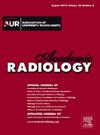使用计算机断层扫描血管造影对非钙化和高风险斑块及其他生物标记物进行客观分析验证的 QIBA 共识概况特别报告。
IF 3.8
2区 医学
Q1 RADIOLOGY, NUCLEAR MEDICINE & MEDICAL IMAGING
引用次数: 0
摘要
理由和目标:通过计算机断层扫描血管造影 (CTA) 对动脉粥样硬化斑块进行成像的临床效用正在得到越来越多的证据支持。越来越多有组织的活动将非钙化斑块(NCP)作为临床试验中正式定义的生物标志物,将高危斑块(HRP)作为临床护理中的生物标志物,将其作为该领域最重要的衡量标准,值得社会各界努力验证。然而,目前还没有能力评估任何特定解决方案的定量性能,以进行这些测量或分类。供应商使用不同的定义、评估指标和验证数据集来描述自己的产品,而临床医生用户却没有能力对准确性和精确性以及这如何影响诊断信心进行客观评估:CTA动脉粥样硬化生物标志物QIBA简介由定量成像生物标志物联盟(QIBA)创建,旨在提高客观性并降低无创斑块表型的可变性。该简介对斑块单独测量和合并测量的准确性和精确性进行了说明:结果:从偏差(准确性)、斜率(偏差在整个测量范围内的一致性,测量变化时需要)和变异性方面对单个斑块形态测量进行评估。多参数斑块稳定性表型根据与病理专家的一致性进行评估。该简介面向广大读者,包括从事发现科学、临床试验和患者护理的人员:本报告介绍了《简介》的基本原理和概述,以及在研究和临床实践中如何遵守《简介》:本文总结了验证非钙化斑块 (NCP)、其他新兴斑块形态测量和多参数组织学定义的高危斑块 (HRP) 分析性能的客观方法,如 CTA 动脉粥样硬化生物标记物 QIBA Profile 所述。本文章由计算机程序翻译,如有差异,请以英文原文为准。
Special Report on the Consensus QIBA Profile for Objective Analytical Validation of Non-calcified and High-risk Plaque and Other Biomarkers using Computed Tomography Angiography
Rationale and Objectives
Evidence is building in support of the clinical utility of atherosclerotic plaque imaging by computed tomography angiography (CTA). There is increasing organized activity to embrace non-calcified plaque (NCP) as a formally defined biomarker for clinical trials, and high-risk plaque (HRP) for clinical care, as the most relevant measures for the field to advance and worthy of community efforts to validate. Yet the ability to assess the quantitative performance of any given specific solution to make these measurements or classifications is not available. Vendors use differing definitions, assessment metrics, and validation data sets to describe their offerings without clinician users having the capability to make objective assessments of accuracy and precision and how this affects diagnostic confidence.
Materials and Methods
The QIBA Profile for Atherosclerosis Biomarkers by CTA was created by the Quantitative Imaging Biomarkers Alliance (QIBA) to improve objectivity and decrease the variability of noninvasive plaque phenotyping. The Profile provides claims on the accuracy and precision of plaque measures individually and when combined.
Results
Individual plaque morphology measurements are evaluated in terms of bias (accuracy), slope (consistency of the bias across the measurement range, needed for measurements of change), and variability. The multiparametric plaque stability phenotype is evaluated in terms of agreement with expert pathologists. The Profile is intended for a broad audience, including those engaged in discovery science, clinical trials, and patient care.
Conclusion
This report provides a rationale and overview of the Profile claims and how to comply with the Profile in research and clinical practice.
Summary Statement
This article summarizes objective means to validate the analytical performance of non-calcified plaque (NCP), other emerging plaque morphology measurements, and multiparametric histology-defined high-risk plaque (HRP), as outlined in the QIBA Profile for Atherosclerosis Biomarkers by CTA.
求助全文
通过发布文献求助,成功后即可免费获取论文全文。
去求助
来源期刊

Academic Radiology
医学-核医学
CiteScore
7.60
自引率
10.40%
发文量
432
审稿时长
18 days
期刊介绍:
Academic Radiology publishes original reports of clinical and laboratory investigations in diagnostic imaging, the diagnostic use of radioactive isotopes, computed tomography, positron emission tomography, magnetic resonance imaging, ultrasound, digital subtraction angiography, image-guided interventions and related techniques. It also includes brief technical reports describing original observations, techniques, and instrumental developments; state-of-the-art reports on clinical issues, new technology and other topics of current medical importance; meta-analyses; scientific studies and opinions on radiologic education; and letters to the Editor.
 求助内容:
求助内容: 应助结果提醒方式:
应助结果提醒方式:


